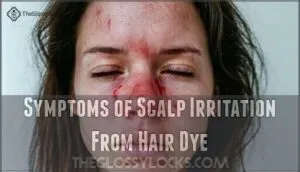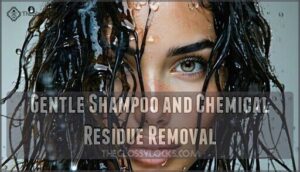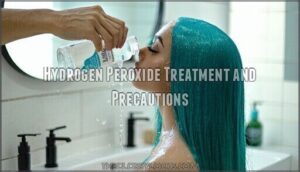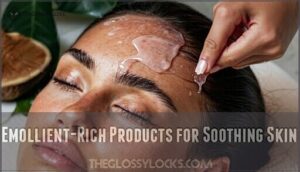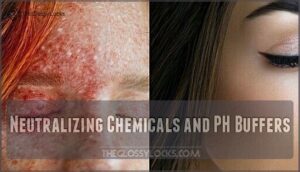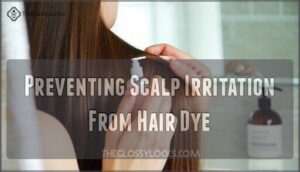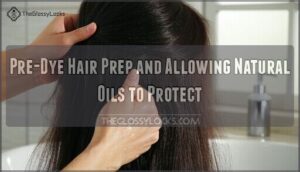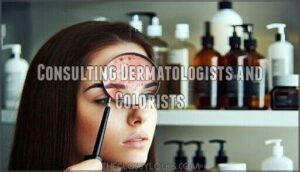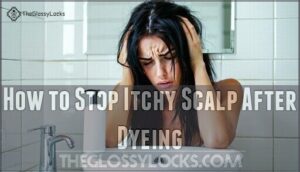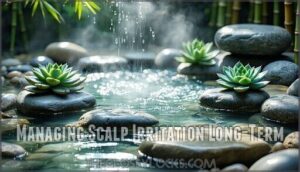This site is supported by our readers. We may earn a commission, at no cost to you, if you purchase through links.
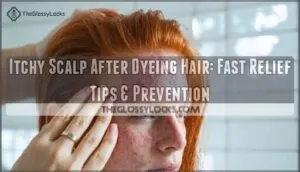
You’re basically dealing with contact dermatitis—your scalp’s way of saying "nope" to those ingredients.
The itching typically starts within hours and can last several days, sometimes spreading to your forehead, ears, or neck.
Your first move? Rinse thoroughly with cool water and use a gentle, sulfate-free shampoo to remove chemical residue.
Follow up with a fragrance-free moisturizer or aloe vera to calm inflammation.
Most reactions resolve on their own, but knowing the right remedies and prevention tricks can save you from future scratching sessions.
Table Of Contents
- Key Takeaways
- Causes of Itchy Scalp After Hair Dye
- Symptoms of Scalp Irritation From Hair Dye
- Immediate Relief Measures for Itchy Scalp
- Preventing Scalp Irritation From Hair Dye
- Natural Remedies and Alternative Options
- How to Stop Itchy Scalp After Dyeing
- Managing Scalp Irritation Long-Term
- Frequently Asked Questions (FAQs)
- Why does my scalp itch after hair dye?
- Can hair dye cause itching?
- How can I prevent my scalp from itching after hair dye?
- What if my hair is itchy after coloring?
- Can hair dye irritate your scalp?
- Why is my scalp swollen after a hair dye appointment?
- How do you stop your scalp from itching after dying it?
- How long does itching last after hair dye?
- Does hair dye cause itchy scalp?
- What causes gray scalp and itching?
- Conclusion
Key Takeaways
- Test before you dye – Always do a patch test 48 hours before coloring to catch potential allergic reactions to PPD and other harsh chemicals before they wreak havoc on your entire scalp.
- Act fast when itching starts – Immediately rinse with cool water and gentle, sulfate-free shampoo to remove chemical residue, then apply soothing treatments like aloe vera or coconut oil within hours of symptoms appearing.
- Prevention beats treatment – Skip washing your hair 24-48 hours before dyeing to let natural oils create a protective barrier, and choose high-quality, PPD-free formulas when possible.
- Know when to get help – If your scalp irritation persists beyond a week, spreads to other areas, or you’re experiencing severe swelling and blistering, consult a dermatologist for proper treatment and allergy testing.
Causes of Itchy Scalp After Hair Dye
When you dye your hair, certain chemicals can trigger irritation that leaves your scalp feeling itchy and uncomfortable.
The most common culprit is para-phenylenediamine (PPD), found in most permanent dyes, along with other harsh ingredients like ammonia and peroxide that can disrupt your scalp’s natural balance.
Ingredients in Hair Dye That Cause Irritation
Several ingredients in hair dye can turn your scalp into an itchy battlefield. Understanding these culprits helps you make smarter choices for your next color session.
Common irritating ingredients include:
- Paraphenylenediamine (PPD) – the top allergen causing burning and redness
- Ammonia – strips natural oils, leaving your scalp dry and vulnerable
- Hydrogen peroxide – can cause chemical burns when overused
- Resorcinol – triggers contact dermatitis in sensitive individuals
- Sodium lauryl sulfate – creates harsh irritation and inflammation
Before your next dye job, look for PPD alternatives and gentler formulas. Your scalp will thank you for doing the homework first. Many dyes also contain sulfates, which can strip natural oils, leading to further dryness and irritation.
Allergic Contact Dermatitis and Skin Sensitivity
Developing allergic contact dermatitis from hair dye creates a frustrating cycle of scalp sensitivity.
Your immune system treats paraphenylenediamine PPD as an unwelcome intruder, triggering inflammation and chronic itch.
This hair dye allergy can emerge suddenly, even after years of safe use.
Patch testing reveals potential reactions before full application, while exploring PPD alternatives protects sensitive skin from ongoing irritation.
Weakened Skin Barrier and Underlying Dryness
Your scalp’s barrier function acts like your skin’s security system, but hair dye chemicals can punch holes right through it.
Hair dye chemicals breach your scalp’s defenses faster than you can say "color correction.
When your scalp barrier weakens, it can’t lock in moisture or keep irritants out, making every subsequent dye job feel like pouring salt on a wound.
Underlying conditions like eczema or seborrheic dermatitis make your skin sensitivity skyrocket.
Here’s how dryness severity impacts your scalp irritation:
- Mild dryness – Temporary tightness and flaking after hair dye application
- Moderate dryness – Persistent itchy scalp lasting several days post-coloring
- Severe barrier damage – Cracking, bleeding, and intense burning sensations
- Chronic compromise – Repeated reactions with each dye session
- Complete breakdown – Open wounds requiring medical intervention
Your dry scalp needs serious scalp hydration before attempting another color change.
Think of it as prepping a cracked foundation before painting.
Symptoms of Scalp Irritation From Hair Dye
Recognizing the signs of scalp irritation from hair dye helps you take quick action to minimize discomfort and prevent worsening reactions.
Symptoms can appear immediately or develop up to 48 hours after dyeing, ranging from mild itching to severe inflammation that extends beyond your hairline.
Common Signs of Allergic Reactions
Recognizing allergic reactions helps you respond quickly when hair dye causes problems. Your body might send warning signals that shouldn’t be ignored.
Watch for these common signs of contact dermatitis:
- Intense itching that worsens over time
- Redness and swelling around your hairline
- Blistering scalp with fluid-filled bumps
- Burning or stinging sensations
Severity variation means reactions range from mild discomfort to serious complications. Anaphylaxis risk, though rare, requires immediate medical attention if breathing becomes difficult.
Duration of Symptoms and Delayed Reactions
Hair dye reactions don’t always show up immediately. Delayed onset can occur 24-48 hours after dyeing, catching you off guard when symptoms finally appear.
Sensitivity development happens gradually – you might use the same dye for years before experiencing allergic reaction.
Minor scalp irritation typically resolves within days, while severe hair dye reactions can persist weeks.
Chronic itch and recurring symptoms may indicate true hair dye allergies.
The reaction timeline varies by individual, making a hair dye patch test essential for future coloring.
Areas Affected Beyond The Scalp
Unfortunately, hair dye reactions don’t always stay put on your scalp.
Contact dermatitis can spread to your forehead irritation, causing facial redness around your hairline.
You might notice eyelid swelling, neck rashes, or ear discomfort – especially behind your ears where dye drips.
These scalp allergies love to wander, turning a simple touch-up into a full-face situation.
Immediate Relief Measures for Itchy Scalp
When your scalp starts itching after a hair dye session, acting quickly can prevent the discomfort from getting worse.
The first step involves removing any lingering chemicals that might still be irritating your skin, followed by gentle treatments that calm inflammation and restore your scalp’s natural balance, which is crucial for preventing further discomfort.
Gentle Shampoo and Chemical Residue Removal
When itchy scalp strikes after dyeing, your first move should be washing with a gentle, sulfate-free shampoo or baby shampoo.
These products won’t strip your already irritated skin while removing chemical residue from hair dye. Consider using products without sulfates for a gentler wash.
Focus on thorough rinsing to prevent residue buildup, then follow with hydrating conditioners to restore moisture and calm scalp irritation.
Hydrogen Peroxide Treatment and Precautions
After thorough washing, hydrogen peroxide can neutralize remaining chemicals causing your itchy scalp.
This antiseptic helps deactivate PPD and other irritants that trigger allergic reactions. Using hydrogen peroxide can lighten hair by exposing underlying melanin pigments.
Safe hydrogen peroxide application guidelines:
- Peroxide Concentration: Use only 2-3% solutions to prevent chemical burns
- Application Timing: Apply briefly, then rinse immediately to avoid color changes
- Patch Testing: Test on small skin area first to check sensitivity
- Professional Advice: Consult experts for persistent or worsening scalp irritation
- Alternative Options: Skip if you have broken skin or severe hair dye safety concerns
Emollient-Rich Products for Soothing Skin
After hydrogen peroxide treatment, emollient-rich products become your scalp’s rescue team.
Apply petroleum jelly or aqueous cream directly to irritated areas for instant relief. These products create a protective barrier while locking in moisture.
Argan oil and coconut oil work wonderfully too—massage gently into your scalp for 1-2 hours.
Consider using an emollient scalp treatment for best results. This scalp treatment tackles dryness and reduces inflammation effectively.
Neutralizing Chemicals and PH Buffers
Beyond soothing emollients, you’ll want to neutralize lingering chemicals causing scalp irritation.
Hair dye chemical reactions disrupt your scalp’s natural acid mantle, making pH buffers essential for proper hair dye aftercare. One should also consider safe removal practices to minimize damage.
Here’s how chemical neutralization helps:
- Buffer Solutions restore your scalp’s natural pH balance after alkaline dye exposure
- pH Balancers counteract harsh hair dye ingredients like PPD and ammonia
- Product Selection matters – choose neutralizing shampoos designed for post-color care
- Acid Mantle protection prevents ongoing scalp irritation causes from lingering chemicals
Preventing Scalp Irritation From Hair Dye
Prevention works better than treatment in the case of hair dye reactions. Simple steps before coloring can save you from days of scalp discomfort and irritation.
Patch Testing Before Dyeing
Before diving into any hair dye adventure, conducting a patch test acts as your personal safety net against unwanted reactions.
Choose a small application area like your inner wrist or behind your ear, then apply a dab of the dye mixture. Timing matters—wait 48 hours while monitoring for signs of allergic reaction.
Reading results carefully helps detect hair dye sensitivity before it becomes a scalp disaster.
| Test Location | What to Watch For | When to Stop |
|---|---|---|
| Inner wrist | Redness, swelling | Immediate itching |
| Behind ear | Burning sensation | Visible irritation |
| Upper arm | Bumps or welts | Persistent discomfort |
This simple precaution transforms your DIY options from risky experiments into informed choices about hair dye precautions.
Informing Your Colorist About Sensitivities
Before your next hair coloring appointment, have an honest conversation with your colorist about any previous reactions or sensitive scalp issues.
This colorist consultation helps them select gentler products and techniques.
Here’s what to communicate:
- Previous Reactions – Describe any itchy scalp, burning, or allergic reaction symptoms you’ve experienced
- Product Ingredients – Mention specific chemicals like PPD that cause problems for your sensitive scalp
- Patch Test – Request they perform a small test area before full application
- Communicate Allergies – Share your complete allergy history, even if it seems unrelated to hair dye
Choosing High-Quality Hair Dye Products
Quality matters when selecting hair dye products for sensitive scalps.
Smart shopping protects against irritation.
Consider these factors:
- Ingredient Analysis: Choose brands with clear labeling that avoid high PPD content and harsh chemicals
- Ammonia Content: Select ammonia-free formulas or those using gentler PPD alternatives like ethanolamines
- Salon Brands: Trust professional-grade products from established names known for hair dye safety
- Organic Dyes: Consider natural formulations that prioritize hair dye quality over aggressive chemical processing
High-quality hair dye ingredients reduce reaction risks substantially.
Many consumers now seek gentle dye options.
Natural Oils Protection and Hair Hydration
Your scalp’s natural oils work like a protective shield when you don’t wash hair 24-48 hours before dyeing. This Natural Barriers approach helps prevent scalp irritation and reduces the risk of an itchy scalp.
Pre-Dye Oils like coconut or argan oil provide extra protection through Oil Application techniques.
| Oil Type | Benefits |
|---|---|
| Coconut Oil | Deep moisturizing, antimicrobial protection |
| Argan Oil | Rich in vitamins, reduces inflammation |
| Jojoba Oil | Mimics natural sebum, gentle hydration |
Scalp Hydration matters most after dyeing. Apply natural oils for scalp moisturizing – leave coconut or argan oil on for 30 minutes before washing.
This hair hydration routine helps repair damage and maintains healthy Oil Benefits long-term.
Natural Remedies and Alternative Options
When harsh chemicals leave your scalp feeling raw and irritated, natural remedies can provide gentle relief without adding more stress to already sensitive skin.
You’ll also discover safer alternatives to traditional hair dye that let you change your look without the chemical aftermath.
Apple Cider Vinegar Rinse and Chamomile Tea
Natural remedies can work wonders for your itchy scalp after dyeing.
Mix one part apple cider vinegar with four parts water for an ACV rinse—the ACV benefits include pH balancing and scalp soothing.
For chamomile tea, steep two bags in hot water, cool completely, then pour over clean hair.
Both treatments offer gentle scalp irritation relief without harsh chemicals.
Oil Treatments for Scalp Irritation
Three powerful oils can rescue your irritated scalp after hair dyeing disasters. Coconut oil contains lauric acid that penetrates deeply, reducing inflammation and boosting hydration. Argan oil delivers antioxidant protection while olive oil creates an emollient barrier against further damage. Tea tree oil fights microbial overgrowth that worsens post-dye sensitivity.
Here are essential application tips for maximum scalp soothing:
- Warm oils slightly before massaging into scalp for better absorption
- Leave coconut oil treatments on for 1-2 hours or overnight for deep relief
- Mix 10-20 drops of tea tree oil with carrier oils to prevent irritation
- Apply pre-shampoo treatments weekly to maintain healthy scalp barrier function
Remember to follow these tips for a soothing and effective treatment, and consider the benefits of using these oils to rescue your irritated scalp.
Pre-Dye Hair Prep and Allowing Natural Oils to Protect
Someone’s natural scalp protection doesn’t require expensive products—your own oils work perfectly. Skip washing 24-48 hours before hair dyeing to preserve this natural barrier.
This Oil Preservation strategy helps prevent itchy scalp reactions by maintaining Hydration Balance and Barrier Strengthening.
| Timing | Scalp Condition | Protection Level |
|---|---|---|
| Day of dyeing | Freshly washed | Minimal protection |
| 1-2 days unwashed | Natural oils present | Good protection |
| 3+ days unwashed | Heavy oil buildup | Maximum protection |
Your Scalp Assessment should guide this approach. Gentle Cleansing afterward removes hair dye residue while maintaining moisture. This simple prep offers freedom from harsh reactions.
Hair Extensions, Glosses, and Wigs as Alternatives
When dye triggers scalp reactions, consider safer alternatives that protect your sensitive skin.
Hair dye alternatives offer color without chemical contact:
- Hair extensions provide instant color changes using clip-ins, tape-ins, or sew-ins made from human or synthetic hair
- Hair gloss adds shine and subtle tint while conditioning your strands, offering temporary enhancement without harsh chemicals
- Wigs deliver complete transformations using hypoallergenic materials like heat-resistant synthetic fibers or natural hair
These scalp protection methods cost varies—extensions range $50-500, glosses $20-80, wigs $30-2000—but eliminate irritation risks entirely.
Consulting Dermatologists and Colorists
When alternatives fall short, professional dermatologist consultation and colorist communication provide essential solutions for persistent scalp irritation.
Dermatologists offer patch test insight and thorough allergic reaction plans, while experienced colorists provide product recommendations and hair dye advice suited to sensitive scalps.
Professional scalp expert recommendations include:
- Dermatologist consultation for allergy testing and medical treatment options
- Hair colorist guidance on ammonia-free and PPD-free formulations
- Ongoing hair dye scalp health monitoring through regular professional check-ins
How to Stop Itchy Scalp After Dyeing
Once your scalp starts itching after dyeing, you’ll need to act quickly to remove chemical residue and calm the irritation.
The good news is that several fast-acting home remedies can provide relief within hours, and adjusting your hair care routine will help prevent future reactions.
Fast Relief Measures and Home Remedies
When scalp itching strikes after dyeing, you need fast relief that works.
Start with Gentle Shampoos to wash away irritating residue, then try Cooling Compresses for instant comfort.
Oil Treatments like coconut or argan oil provide deep Scalp Hydration, while an ACV Rinse balances pH levels naturally.
| Remedy | Application | Relief Time |
|---|---|---|
| Cold compress | Apply 10-15 minutes | Immediate cooling |
| Gentle Shampoos | Wash 2-3 times gently | 30 minutes |
| Oil Treatments | Leave 1-2 hours | 2-4 hours |
| ACV Rinse | Rinse after shampooing | 1-2 hours |
| Aloe vera gel | Apply thin layer | 15-30 minutes |
These anti itch solutions target hair dye irritation directly, providing scalp relief and soothing scalp comfort when you need it most.
Adjusting Hair Care Routine After Dyeing
Recovery requires gentle patience with your traumatized scalp.
Your scalp care routine needs these essential changes:
- Switch to gentle products – sulfate-free shampoos protect irritated skin
- Embrace hydration focus – deep conditioning treatments restore moisture balance
- Practice scalp massages with fingertips to boost circulation gently
- Master avoiding heat – let hair air-dry while healing occurs
These routine changes transform post dye care into effective hair dye aftercare.
Avoiding Irritating Ingredients and Products
Reading labels becomes your superpower once you know what to avoid. Ingredient research helps you spot troublemakers before they touch your scalp. Look for hypoallergenic dyes and paraben free dye options that won’t trigger reactions.
Common culprits lurk in everyday hair products, so checking ingredients protects your sensitive skin from future flare-ups. Harmful ingredients like sulfates can be a source of irritation.
- Avoid PPD and ammonia free dye alternatives reduce chemical exposure
- Skip harsh sulfates like sodium lauryl sulfate that strip natural oils
- Choose fragrance-free formulas to minimize allergic reactions
Product alternatives exist for every hair type and color goal, making it easier to maintain gorgeous hair without the itch.
Managing Scalp Irritation Long-Term
Long-term scalp health starts with consistent hydration and gentle care routines that protect your skin barrier from future irritation.
You’ll need to balance moisture levels, avoid harsh treatments, and know when professional intervention becomes necessary for persistent problems.
Maintaining a Healthy Scalp and Hair Hydration
Long-term scalp health starts with consistent scalp moisturization and proper scalp care routines.
Use gentle, sulfate-free shampoos and incorporate scalp massages to boost circulation.
Stay hydrated—water intake directly affects skin health.
Gentle brushing prevents irritation while a balanced diet rich in vitamins supports healing.
These habits prevent future reactions to hair dye and maintain ideal scalp health.
Regular Trims and Avoiding Heat Styling
With regular trimming every six to eight weeks, you’ll prevent split ends from traveling up the hair shaft and causing additional scalp irritation.
Heat damage reduction becomes essential after dye-related scalp issues—embrace your natural texture and air-dry when possible.
Low-heat settings protect both your color and sensitive scalp from further irritation.
Regular trims also help with retaining hair length.
Considering Professional Help for Persistent Irritation
When persistent symptoms like ongoing scalp inflammation refuse to budge, it’s time for a dermatologist referral.
A specialist consultation can identify specific triggers through advanced testing, revealing whether you’re dealing with a hair dye allergic reaction or other scalp irritation causes.
Dermatologist recommended treatments include prescription solutions customized to your itchy scalp needs, ensuring lasting relief.
Frequently Asked Questions (FAQs)
Why does my scalp itch after hair dye?
Your scalp itches after hair dye because chemicals like paraphenylenediamine (PPD) and ammonia irritate sensitive skin, causing contact dermatitis with redness and inflammation.
Can hair dye cause itching?
Imagine this: you’ve just finished dyeing your hair, but now your scalp feels like it’s hosting a tiny dance party of irritation.
Yes, hair dye can absolutely cause itching due to harsh chemicals like PPD, ammonia, and peroxide that strip natural oils and trigger allergic reactions, specifically causing irritation.
How can I prevent my scalp from itching after hair dye?
Perform a patch test 48 hours before dyeing to identify potential allergic reactions. Choose PPD-free dyes, apply protective barrier cream around your hairline, and avoid over-processing by following timing instructions carefully.
What if my hair is itchy after coloring?
Like a medieval scribe documenting ancient remedies, you’ll want to immediately rinse your hair with gentle shampoo to remove chemical residue.
Apply soothing treatments like aloe vera or coconut oil to calm irritation and restore balance.
Can hair dye irritate your scalp?
Yes, hair dye can definitely irritate your scalp. Common culprits include PPD, ammonia, and peroxide, which can cause redness, burning, and itching even if you’ve used the same dye before.
Why is my scalp swollen after a hair dye appointment?
Your scalp screams in distress, inflamed and tender to the touch.
You’re experiencing an allergic reaction to hair dye ingredients like PPD or ammonia, causing contact dermatitis with swelling and irritation.
How do you stop your scalp from itching after dying it?
Wash your hair immediately with gentle shampoo to remove dye residue, then apply soothing treatments like coconut oil, aloe vera, or cool compresses to calm irritation.
How long does itching last after hair dye?
Oh, the classic "dye and cry" dilemma! Your scalp’s itching typically lasts 2-7 days after hair coloring, though severe allergic reactions can persist for weeks without proper treatment.
Does hair dye cause itchy scalp?
Hair dye can definitely cause an itchy scalp.
The culprit’s usually para-phenylenediamine (PPD), found in most permanent dyes, along with ammonia and other harsh chemicals that strip natural oils and irritate sensitive skin.
What causes gray scalp and itching?
Like storm clouds gathering overhead, gray scalp appears when hair dye chemicals strip natural pigments and oils.
You’re experiencing irritation from ingredients like PPD, ammonia, or peroxide causing inflammation, dryness, and that persistent itching sensation.
Conclusion
Don’t bite off more than you can chew when dealing with an itchy scalp after dyeing hair.
Understanding the causes, from harsh chemicals to allergic reactions, empowers you to take swift action.
Quick relief through gentle cleansing, soothing treatments, and proper aftercare can minimize discomfort substantially.
Prevention remains your best defense—patch testing, choosing quality products, and protecting your scalp beforehand.
If symptoms persist beyond a few days or worsen, consult a dermatologist for professional guidance and treatment options.
- https://www.healthline.com/health/hair-dye-allergy
- https://www.headandshoulders.co.in/en-in/healthy-hair-and-scalp/scalp/itchy-scalp/hair-dye-cause-itchy-scalp
- https://www.verywellhealth.com/hair-dye-allergy-82754
- https://pmc.ncbi.nlm.nih.gov/articles/PMC3262542/
- https://myacare.com/blog/all-you-need-to-know-about-hair-dye-allergies-symptoms-causes-and-treatment

